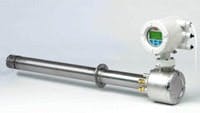ABB Instrumentation has launched its next generation of combustion gas analyzers for industrial and utility boiler applications. Featuring a revised sensor design and an increased choice of probe lengths up to 13.12 feet (4 meters), the Endura AZ20 expands ABB’s offering to a range of high temperature applications up to 800°C.
Manufactured using a ceramic-tosteel bonding process, the Endura AZ20 offers improved resistance to thermal stresses and shocks compared to a conventional brazed design. This enables it to be used in a range of applications subject to sudden variations in process temperature, as well as offering a gas-tight bond throughout its operating temperature range.
The Endura AZ020 benefits from a cell processing technique which bonds the multi-layered platinum electrode to the zirconia. This means that the AZ20 can be used in arduous applications subject to sulphurous and reducing atmospheres, such as sulphur recovery processes, crematoria and industrial and clinical waste incineration.
With fewer parts requiring servicing or replacement, the AZ20 offers simplified maintenance. In the event that problems do occur, the AZ20’s NAMUR compliant diagnostics, with alarms and warnings in clear text, enable operators to quickly trace and rectify the fault.
Operation has been simplified by the use of ABB’s universal Human Machine Interface (HMI), which has now been extended across its range of instrumentation products. Enabling operators to scroll through and select options, the HMI simplifies operation, maintenance and training, reducing cost of ownership and providing a consistent user experience. “Through-the-glass” control technology provides a local operator interface for inputting short, quick data for all user-specific parameters without removing the transmitter cover.
As a HART-enabled device, the Endura AZ20 also offers the ability for operators to perform online modification and monitoring of parameters. Improved process control is ensured by the positioning of the zirconium oxide measuring sensor at the tip of the probe, which is then inserted into the flue duct. This offers the ideal position for direct in-situ measurement, enabling users to get an accurate and immediate oxygen reading for optimizing the combustion control process.
Another new feature is the inclusion of integrated calibration technology, which automatically controls both the test gas flow rate and test gas sequences during calibration testing. This eliminates the need for expensive ancillary equipment typically needed for traditional flue gas oxygen analyzer systems and prevents incorrect calibrations caused by the loss of test gas.




